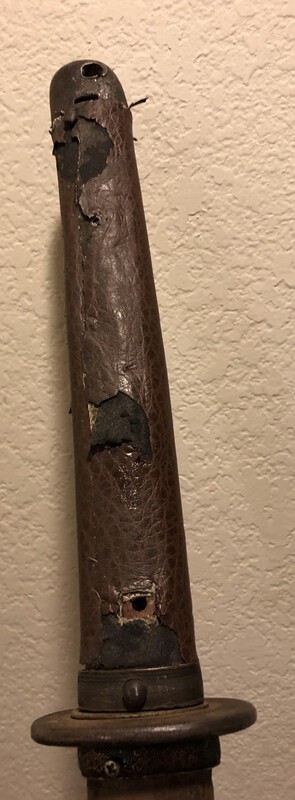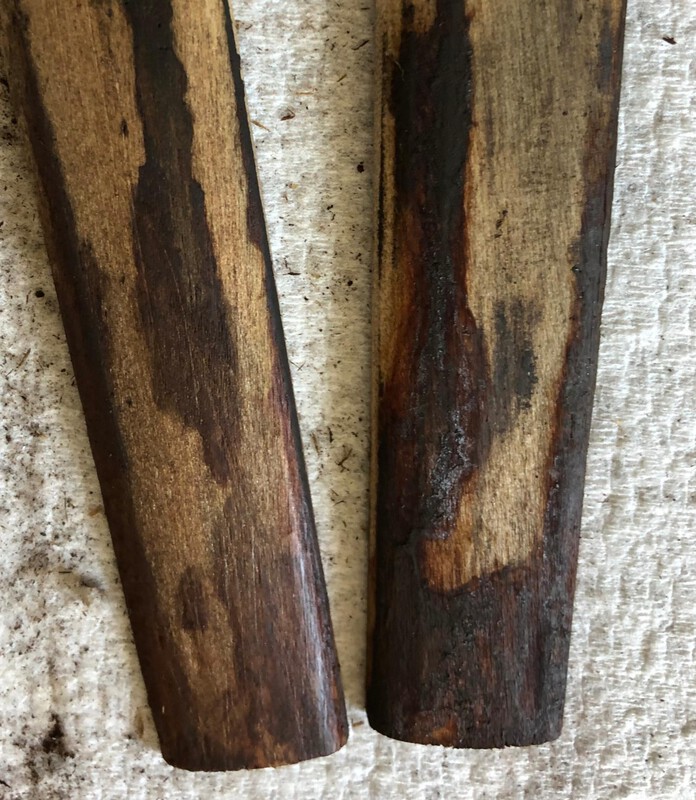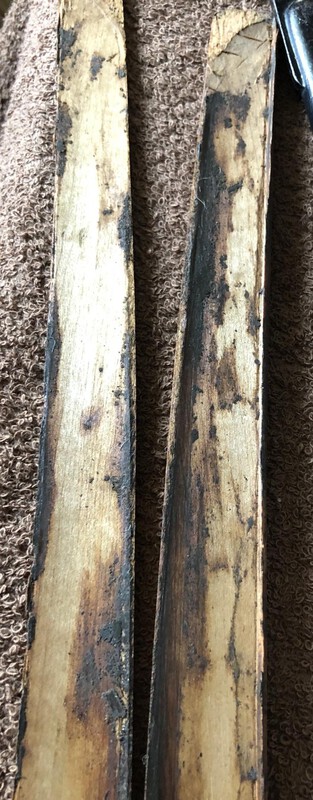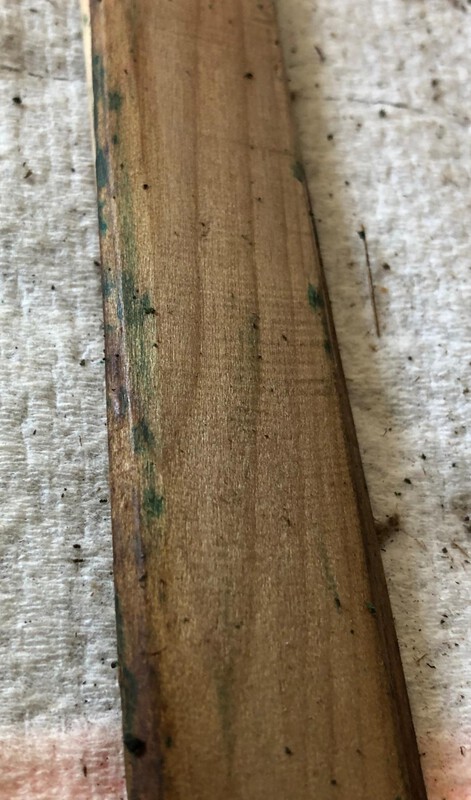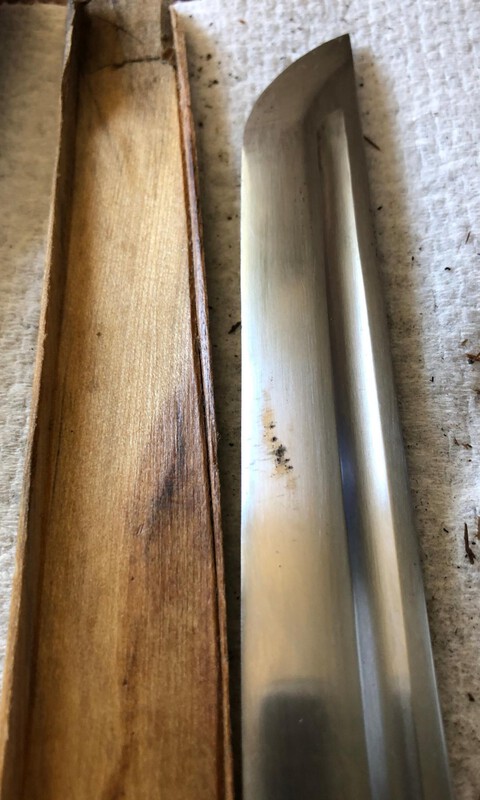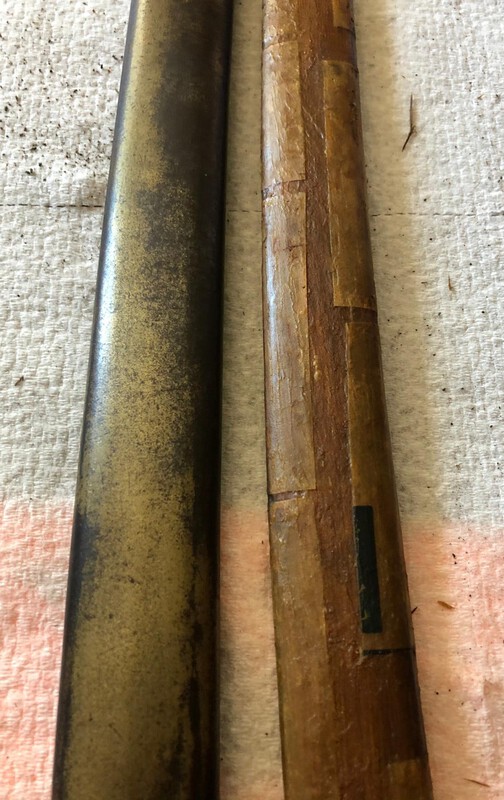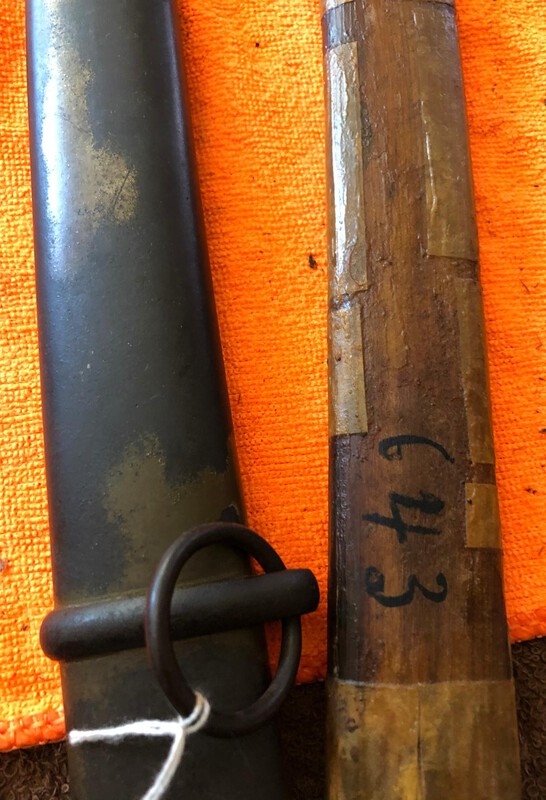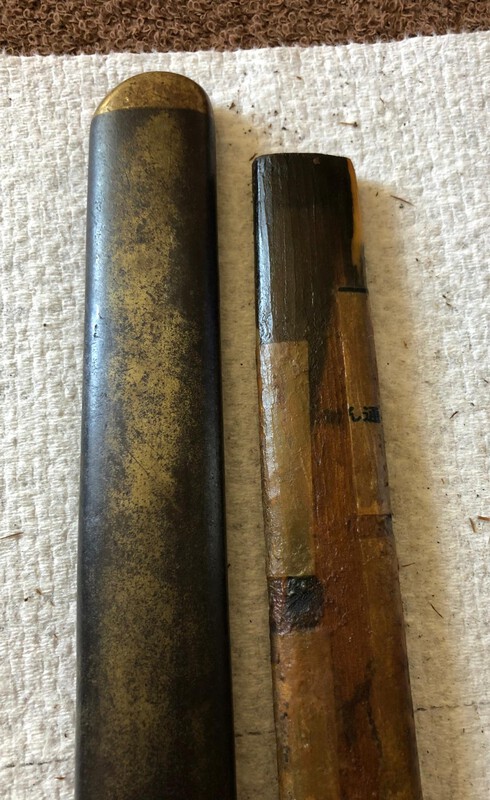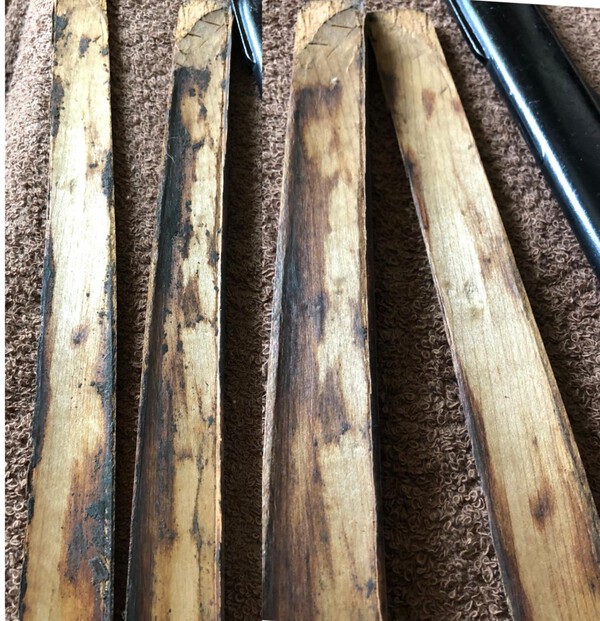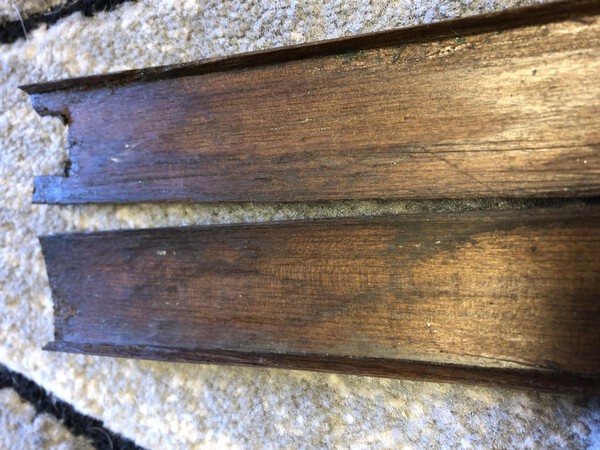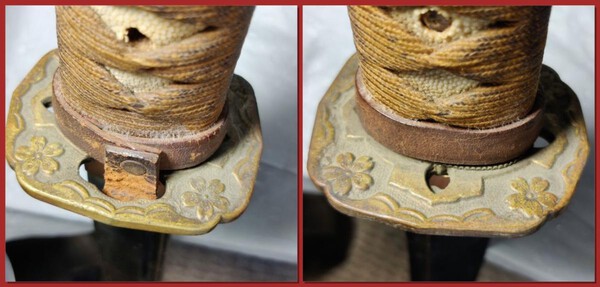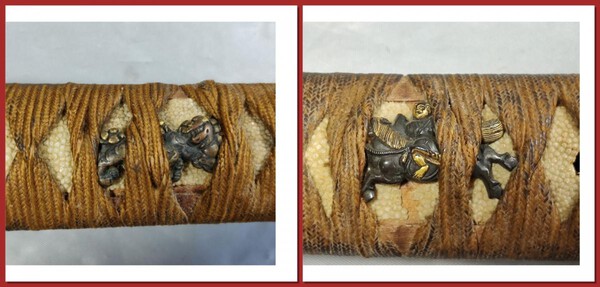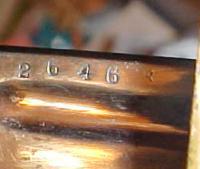-
Posts
13,032 -
Joined
-
Last visited
-
Days Won
155
Content Type
Profiles
Forums
Events
Store
Downloads
Gallery
Everything posted by Bruce Pennington
-
Neil, From the top - Seki, 特 = TOKU, and Unknown. I haven't found anyone who recognized that bottom one, probably because there isn't enough detail to make out the strokes. Also, I don't know the meaning of the Toku, so if someone does, please let us know! If yours is a June 1944, I have it in my data already. If another month, please let me know!
-

"Weed Whacker" Katana Translation help?
Bruce Pennington replied to JeffreyM's topic in Translation Assistance
Jeff, That's a personal decision only you can make, as to polishing, and will depend upon your budget ($100 per inch) and plans for the blade. The guys think this was a mass-produces blade, so the value added by a polish will have to be simply your own appreciation, as the polishing cost will exceed the market value of the whole sword. I don't know enough about that world to know if a polisher can simply de-rust the blade at a cheaper price and not do a full polish. You might write to a polisher and ask. There are several in the "Links" tab at the forum top bar, then far right "restoration." I used David Hofhine (davidhofhine@gmail.com) for my Mantetsu. I'd ask him. -
Showa Stamp Of the vast number of blades we've seen with the Showa stamp, I only have 3 - THREE - with confirmed dates: 1940-Kaneuji, Feb 1940 Kanetako, and 1941-Kanemichi. The rest (16 of them) I could not find dates on the posts where they were discussed. If you have blades, or know of links to them, with Showa stamped blades that are dated, please add them to this thread for my records. I would like the smith name too, if known. Seki I have dated blades in every year from 1941 to 1945. Ohmura has 1 or 2 dated 1938, but I don't have anything prior to 1941, so if you know of examples of dated blades with the Seki stamp prior to 1941, please post. Both Seki & Gifu I only have 2 examples: 1944-Kanehide and 1945-Hiromitsu. If you have examples of blades with both stamps, please post. Gifu I have 4: Nov 1943-Hiromitsu, Dec 1943-Unknown, Oct 1944-Uknown, and Feb 1945-Ichishige. I could use more data on Gifu stamped blades, with smith and date. Thanks in advance!
-

Star Stamped Tsutsui Kiyokane Blade
Bruce Pennington replied to cisco-san's topic in Military Swords of Japan
Dave, I'll have to say that, knowing the multitude of variations in WWII gunto, there very well may be some Rinji that were built from the beginning with two mekugi. Even with one in hand, there would be no way to know without removing the ito and same' to see if the wood was notched for a metal plate. -

Star Stamped Tsutsui Kiyokane Blade
Bruce Pennington replied to cisco-san's topic in Military Swords of Japan
Dave,Actually, the "type 3" or Contingency model (Rinji-seishiki), was designed with the lower ana being filled with a screw. They have a thin metal plate on the other side for the screw to attach to. The upper ana takes a mekugi. I'd say 80% of these are lost through time, so people replace them with mekugi. I usually see them for sale with a mekugi in the lower ana and the upper ana empty (likely because someone has removed the upper one to replace the missing screw. Here is one with the ito and same' gone, showing the square where the metal plate fits (missing on this one. A Bubba had put a bolt and nut in it, along with naugahayde for handle wrap!) -
Here's the direct link to the seller's thread: https://forums.gunboards.com/showthread.php?1160271-WTS-Reference-book-collection
-
Laura, The other guys will have to help you with the age, but it looks pretty old to me. You can get a great understanding of the parts at Ohmura's website: http://ohmura-study.net/905.html That page breaks down the parts and gives exquisite pictures of them all. At the index page, you can see all the areas his covers, each with fabulous pictures: http://ohmura-study.net/900.html Frankensword - ha! yes, but quite unique, as your story means it was put together at the end of the war, in Japan. The occupation time at the end of the war is a very important time in history. I consider even the souvenir swords of that phase, important pieces that help record the story of Japan.
-
Ok, this is getting interestinger and interestinger! Navy fittings (missing 1 belt hanger 'ashi') on an army metal saya (scabbard), with civil tsuba (handguard), non-navy colored ito (handle wrap), and army menugi (3 blossom device on either side of the handle under the wrap). I can't recite the timeline on sword confiscation at war's end, and then when they allowed people to keep them again, but this has that "demiliterized" look that the Army PX souvenir sword had (not the same rig at all, just similar mix of army/navy parts). All the parts on yours look like legitimate war sword parts, but they have been mixed - army/navy/civil - most likely to get around the prohibition of selling war weapons. I like the blade!
-

Wet, dirty Saya Liners
Bruce Pennington replied to Bruce Pennington's topic in Military Swords of Japan
Ok, could be! I have an example on the outside of the liner ends where rust from the inside of the steel saya was "growing" into the wooden tips. So, your idea may explain it. But now, I'm still at a loss in understanding the permanent black stains I find on blades. One of our guys had proposed the tannin idea, that it was leaching out of the wood and into the steel. If that's not the case, then what would be causing those spots? It's not rust. -

Wet, dirty Saya Liners
Bruce Pennington replied to Bruce Pennington's topic in Military Swords of Japan
Found that even though a liner may have tannin stains, they don't always stain the blade. In fact, most of these stains are not found on the blades. this one has extensive stains, while the blade is unmarked Most if not all, had wet stains at the opening of the saya throat, which makes sense, as the first part of the liner absorbs the majority of the oils as the blades slides in. Goes as a reminder to not leave standing oil on the blade! My late-war liner was actively wet! The outside even had greenish moldy looking spots! I had already sanded this before the picture was taken. -

Wet, dirty Saya Liners
Bruce Pennington replied to Bruce Pennington's topic in Military Swords of Japan
Got to check a few more today. One was dry and clean. Second one was still tightly glued together along the mune side! I could open it just enough to clean a spot or two, but mostly in good shape. Third had only 1 half of the liner!!! And it was on one of my near-mint 95s! You can see where the tannin put a permanent stain on the blade Checking my copper liner was a surprise! The halves were sealed tightly with glued strips of paper! The end was made differently than the liners of the aluminum models. -
Not an identical mei, but similar: http://japaneseswordindex.com/oshigata/ujifusa2.jpg
-
Wow, there's a whole web-page on this smith's mei: http://www.nihontocraft.com/Izumi_no_Kami_Kunisada_mei.html You could go there and compare the various examples with yours to see what you think. Like the other guys pointed out, even if it is gimei, it is still a very old Japanese sword. There is a story of a Shogun who was given a sword as a gift, and it had a gimei signature, but everyone knew it, and he accepted the gift for the value of the sword. Here is a couple of mei from that site, with yours to compare: To my VERY untrained eye, I see some strokes missing on at least 3 of the kanji on your blade. We would still very much like to see pictures of the whole blade with close-ups of the blade tip and a selection of mid-blade (for details in the metal).
-
Thanks for the pics Robinson. The hamon is quite faint and hard to see. The Nihonto guys can correct me if wrong, but I believe this to be an oil-quenched, non-traditionally made blade (like the vast majority of WWII blades). The two holes in the nakago indicate this was made for the Rinji-seishiki (Type 3) fittings. The multiple stamps are not unheard of on showato, though not the norm, but I agree yours having both the Seki and Gifu stamps put it in the "scarce" or "rare" category.
-

Need help identifying this sword
Bruce Pennington replied to JustHenry's topic in Military Swords of Japan
Manuel, For my own education, what is meant by "practice sword?" Do you think it was made in Japan as a practice sword? The blade shape looks authentic as does the nakago jiri. The etched name "Randal" and possibly a unit "IIXII" could be the guy that brought it back, if made during the war (for practice). -

Wet, dirty Saya Liners
Bruce Pennington replied to Bruce Pennington's topic in Military Swords of Japan
Zzzzzzz! What? Oh I sleep pretty good! Ha! -

Wet, dirty Saya Liners
Bruce Pennington replied to Bruce Pennington's topic in Military Swords of Japan
That's right. I already feel better about the unpolished 95s going back into cleaned liners. It's going to bug me now, until I can get the other one's checked and cleaned. -
You can click the “Edit” in the bottom right of you post, the click “more reply option”. Scroll down and you’ll see picture upload.
-
Someone on another thread wanted dimensions of the liner from a Type 95 saya, so I slid one out and posted the measurements. But afterward, I noticed how wet and saturated the ENTIRE liner was! I left it by the floor vent of a room that gets the most A/C air movement for a few days just to dry it out. After drying, I rubbed the inside with folded paper towels and was appalled at the grime that came out. Since then, I've checked 3 other 95 saya. One was ok, the other two had scattered black build-up that I think is the "tanins" (if that is the right word) that can permanently stain the blade! I used course copper-wool to sand that down, and then used folded paper towels to rub the surface down, removing grime and smoothing the surface. I have 4 more to check, but wanted to put this out there. If you are able to easily remove the liners of your gunto, it might be worth checking. I've tried this on my officer gunto, but have been unable to get most of them (only 1 came out) to come out. My dad's Mantetsu liner is locked in like it was glued or something. Dry, but heavy black build-up (before & after) Entire liner soaking wet
-

Need help with date and stamp
Bruce Pennington replied to Itomagoi's topic in Translation Assistance
That's interesting! It is in the right place for a star stamp. All other stamps are normally found on the upper right of the ana. There has been confusion about the star for decades, and many felt is was just another mandated stamp indicating "non-traditionally made". So, there have likely been several removed over the years because of that misconception. My main source concerning the stamp is Chris Bowen, who stated: "Regarding the star stamp and its use, Rikugun Jumei Tosho, and whether or not these are traditionally made or not, modern research has shed a great deal of light and shown that in general star stamped blades were traditional in both materials and manufacture. There has been a great many falsehoods perpetuated in Japan, and elsewhere, as concerns these blades in the past. We know better now... Chris Bowen 鐵會 Tetsu Kai" -
Robinson, welcome back! I'll let the Nihonto guys help you with your old blade, but I'd like to address a couple things you mentioned about your showato. Calendar - I'm wondering where your confusion is coming from on the month. According to what I've read, the Japanese switched to the Gregorian calendar in 1873. Even when considering their use of a Fiscal Year in factory/arsenal documents, the months were still the same as ours. So "One" month is January, like on your blade. Stamps - over the years, there are some who have argued that a Seki, or regional stamp, could have been simply been like a guild mark and had no statement about how it was made. But the majority of what I read is that simply wasn't the case in WWII. In fact, it is widely known that some people would have a polisher remove the stamp, because it denoted a non-traditionally made blade and they wanted to get more money out of the sale. With the stamp missing, they could claim "gendaito" and ask more for it. You haven't shown us the blade. Asking us whether it could be traditionally made, without showing us the blade, is like asking us if your Ford Cobra is real or a replica without showing us the car. Sometimes it's hard to say, even with pictures, but sometimes it is obvious.
-

"Weed Whacker" Katana Translation help?
Bruce Pennington replied to JeffreyM's topic in Translation Assistance
Jeff, Nobody has mentioned it yet, but do yourself a favor an never touch the blade with your bare fingers. The skin oils can make permanent stains. Be sure to wipe the blade with a soft cloth and a light oil. You can buy blade maintenance kits that come with a great smelling oil, pretty cheap. Here is a page on general blade care: http://japaneseswordindex.com/care/handling.htm -
Here's one that isn't quite the same, but it's quite thin and resembles this in certain ways. It seems half-way between the OP example and a standard tsuba. It's on a civil blade mounted for the war. Here: https://www.wehrmacht-awards.com/forums/forum/ken-jasper-international-militaria-forums/Japanese-militaria-forum/11682681-ww2-Japanese-samurai-sword
-

Help With Miyaguchi/ikkansai Kunimori Please
Bruce Pennington replied to Navymate's topic in Military Swords of Japan
My 2 cents - the stamping of non-traditional blades, didn't really kick in in a big way until December of 1940. There were many non-traditional blades made prior to that which never got stamped. Blades can be found prior to that with stamps, but they are few in number.



